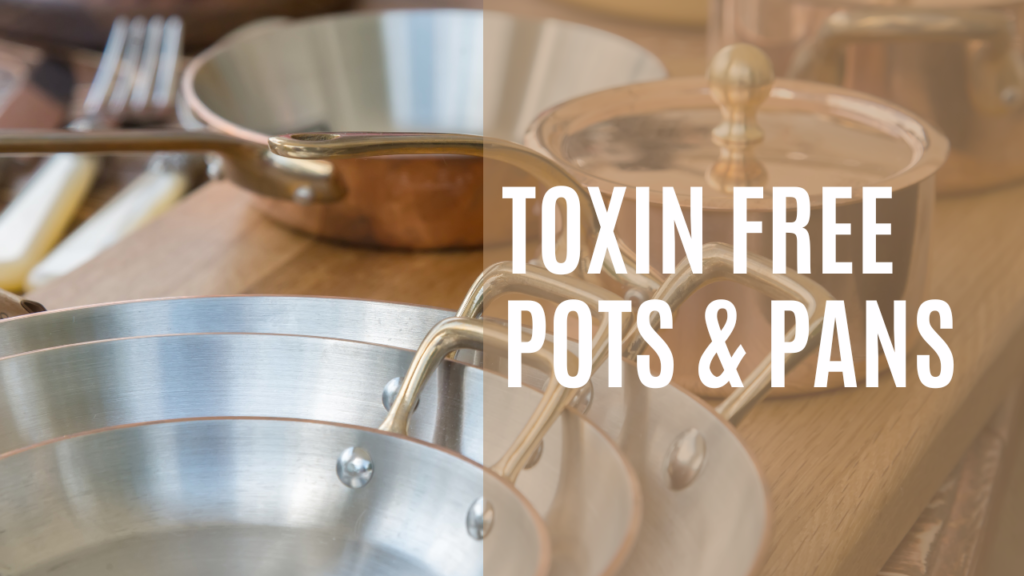
One of my very first changes in our home to make it less toxic was switching over to non toxic cookware. It actually stemmed from our drinking water becoming contaminated with improperly disposed of teflon.
These contaminated wells were the link to several cancer diagnoses, health ailments and a number of lawsuits against the local company dumping the contaminants. And it left me with the burning question: Then why are we cooking and eating with this if it’s so toxic?
It was one of my first glimpses into the unfortunate side of consumerism that wasn’t all that honest. I was frustrated that companies were making cookware out of this toxic product and touting it as “healthy.”
The use of Teflon pans before this incident was my cookware of choice. The idea was you don’t have to use any oil in your cooking, so these non-stick pans were actually healthier. After realizing how horribly toxic it was, I made the switch to stainless steel, which my Grandma used ever since I could remember. My second realization was that new technologies are not always better.
I didn’t really look into other forms of cookware until my youngest daughter had a mild iron deficiency. Not enough to cause alarm, but just enough to cause restlessness at night. The only form of protein she really loved that contained iron were eggs. Our pediatrician recommended using a cast iron pan for the eggs to help improve her iron levels just a smidgen.
As we tried this new method, it really seemed to improve most of her symptoms that came along with lower iron levels. I had yet another realization that what we are cooking IN is also entering our bodies, even if in small amounts.
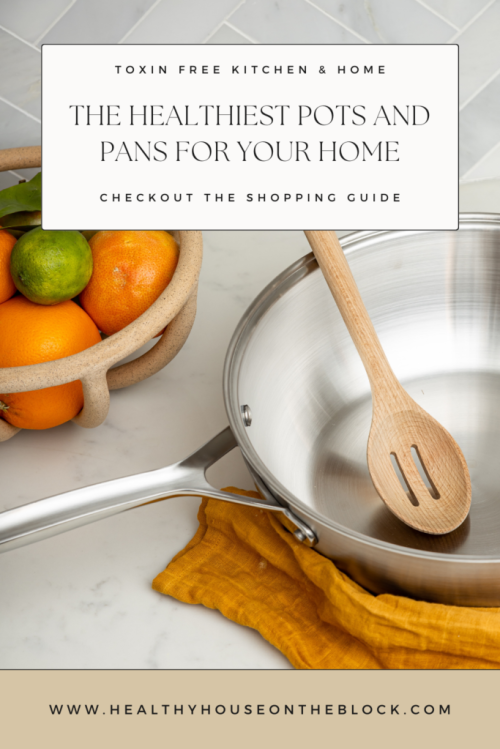
WHY OUR COOKWARE MATTERS TO OUR HEALTH
The most harmful way to come into contact with any toxin is through ingestion. Anytime we ingest anything, it has a direct route to the bloodstream and begins affecting the body right away.
You might think that food is the only way you introduce chemicals and toxins through ingestion, but what you cook your food within plays a part too. The pots and pans we cook in play a huge role as our food is in direct contact with it.
First, when a cooking medium is heated, it can often times leach out into food. The higher the heat of a pan, the more of the components of the pan (or toxins in many cases), can leach out into our food.
Second, bits of the pan, especially if there are scratches can end up within our food. In some cases, like cast iron, it’s beneficial to the body. However, in most cases, heavy metals and toxins can be entering our bloodstream through ingestion. Making sure there are no scratches or chips can help this, but really it can be completely avoided by using a safe cookware option.
Finally, the heating process of the pan can cause many of the materials within a pot or a pan to off-gas into the air. If you’re standing over the food you’re cooking, your inhaling those gases, which are entering your body. Using a vent fan can help minimize this, but the ultimate way to avoid this problem of inhaling toxins is by using a safe cookware.
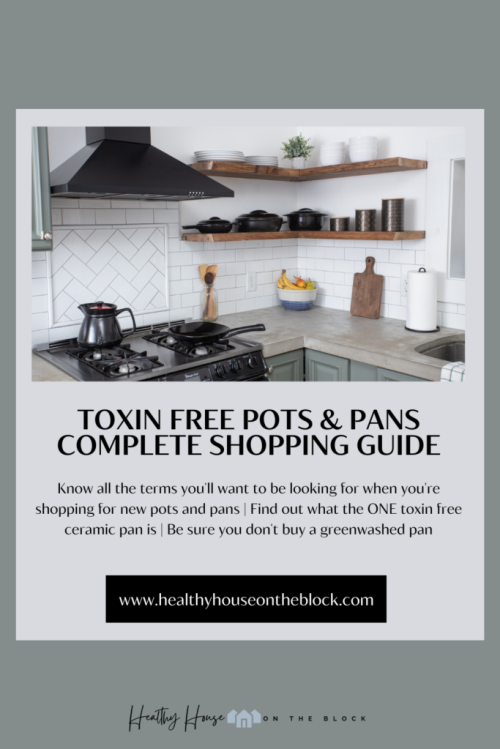
MATERIALS TO AVOID IN POTS AND PANS:
Aluminum: Highly reactive and a known neurotoxin that affects over 200 important functions within the human body (Study) Linked to Alzheimer’s disease and dementia and nervous system damage (Study). Also linked to autism spectrum disorders (Study)
Nanoparticles: This is a relatively new toxin to be aware of, but essentially it’s a byproduct of ceramic coatings that is leached into our food and body. It has been shown to cause a disruption to the immune system as well as precancerous lesions in the intestines. (STUDY)
Chromium: Mostly found in stainless steel, chromium is much more likely to cause issues in children and babies than in adults. Chromium is quickly distributed throughout the body to nearly all tissues, but is concentrated in the kidneys and liver. It has been linked to miscarriages, low birth weight and other reproductive issues. (STUDY)
Teflon: Non-stick pans contain polytetrafluoroethylene, which is extremely toxic. It is known as a forever chemical because of their inability to break down in the environment, and they have become a HUGE problem. When heated, Teflon releases at least six toxic gasses, most of which are carcinogenic. Teflon is highly toxic when heated, and quickly reaches an unsafe temperature when just preheating. (Study) It has been linked to cancer, increased tumors and reproductive problems. (Study) Another scary statistic: 98% of Americans have detectable levels of PFAS or PFCs in their bodies.
And while we’re really raining on the teflon parade, there’s more health effects that have come to light in the last several years: suppressed immune function, increased allergies and asthma, metabolic diseases (obesity and diabetes), endocrine disruption, and increased chance of miscarriage.
Perfluorooctanic Acid (PFOA): Another non-stick product linked to development of tumors. It has also been shown to have a negative effect on immune systems, endocrine systems and hormone production as well as the liver. (Study)
Copper: Copper quickly and easily leaches into food when it is in contact with acidic foods. Over consumption of copper can lead to ulcers and liver damage (Study). Copper also suppresses zinc levels, leading to the malfunctioning of the adrenals and thyroid gland.
Lead: Some cookware that is ceramic, enamel or glass can have lead mixed in to reduce breakage. Lead is highly toxic and has a wide range of symptoms as it accumulates in the body from anemia to kidney and brain damage. (Study)
Cadmium: Cadmium is also in glazes on cookware to give them a uniform color and more balanced heating abilities. Cadmium is a toxic metal and a known human carcinogen. It can build up in the kidneys and liver over time and stays in the body for a very long time. (Study). This can lead to kidney disease and dysfunction as well as bone demineralization. (STUDY)
Nickel: While nickel is a naturally occurring metal, excessive exposure has been linked to lung and nasal cancers as well as dermatitis and neurological effects. (Study). And it’s also important to know that children are much more sensitive to nickel in comparison to adults.
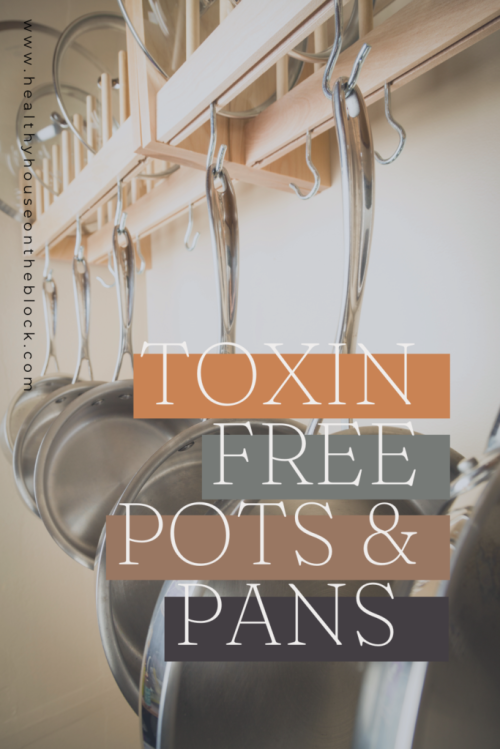
HOW TO SHOP FOR NON-TOXIC POTS AND PANS:
California Proposition 65 Warning: A really useful tool that you can keep an eye out for is the California Proposition 65 warning, as it identifies an extremely extensive list of synthetic chemicals that are known to cause cancer, birth defects or reproductive harm.
Chemicals that are included on their list include household products, food, solvents and more. But the one thing to know is that if a cookware product or line passes the Prop 65 leach test, you can keep in mind that the product is likely less toxic than an alternative.
Avoid Non-Stick Altogether: And that means even the newer ceramic-coated cookware options that claim to be non-stick. While yes, many of them will claim to be free from PTFEs and PFOAs, what they actually use to create a non-stick surface is likely a similar toxin. Some pans use a silicone-based coating, which unfortunately only lasts 2-3 years (and that’s if you don’t use them every single day). This means every 2-3 years, you’re replacing your pans, which is expensive and wasteful.
Find a Long Term Solution: I am a firm believer in the “buy it for life” approach. I have two theories on buying something for life. One, every time you bring a new product or material into your home, you’re potentially exposing your family to toxins. So essentially, the less you bring into your home, the fewer toxins you’re exposing yourself or your family to.
Second, buying something that you’ll likely need to replace in a few years is not only expensive, but it’s so hard on the environment. Choosing something that you’ll have for life (this can be very hard to find nowadays!) is one of the best ways to reduce your carbon footprint. In the same breath, replacing things when they have completely worn out is another practice we’ve tried to follow in our home.
The Outermost Layer Matters Most: Remember that some toxins may be at the center of a pot or pan. LIkely any toxin in the interior of a pan is of very little concern to our health. Aluminum, for example, is often used at the center of a pan because it is excellent for evenly disbursing temperature. You’re not going to be exposed to any aluminum used in the core of a pan (unless your pans have deep scratches).
Another example is with my favorite brand, Xtrema. Although an independent test using an XRF instrument found trace amounts of chromium, nickel and cobalt, this is in the interior most layer and is naturally occurring in the clay used. The outermost layer is free from any leaching chemicals per the Prop 65 leaching tests, which means you’re not exposed to these toxins while using the pots and pans.
If you HAVE to Have Nonstick, Make a Better Choice: And you know that I am not someone who believes in 100% toxin free everywhere in your home. I get it — we’re humans and we need to have some modern conveniences. If you MUST use a nonstick pan (eggs are a big one that just cook better in a nonstick pan), make a better choice. Avoid Teflon and at least use a ceramic coated pan that uses silicone instead of PFOAs or PFTEs. And then commit to using the pan as seldom as possible. And if the pan gets a scratch — throw it away immediately.
CHOOSE THE BEST MATERIALS FOR NON TOXIC POTS AND PANS:
Stainless Steel: What you want to look for here is stainless steel that does not contain large amounts of nickel or chromium. The way you can look for this is to find non toxic pots and pans made of surgical grade stainless steel. And if you can’t find this in your budget, at least opt for a nickel-free stainless steel.
Another claim you can look for is 5 ply 403 stainless steel cookware. This will ensure there is no nickel in the pots and pans. You can also look for 18/0 nickel free.
If you don’t have any sensitivities to nickel, you can opt for a 304 Stainless Steel, which will have trace amounts of nickel that are naturally occurring in the material.
Cast Iron: A tried and true standard in the kitchen. And while they do require seasoning and care that other pans may not, over time this means they can become almost completely non-stick. One benefit for most people is that because cast iron is made of, well, iron, it means that some iron can leach into your food — which is oftentimes a benefit. However, if you’re someone who has a lot of heavy metal sensitivities, this may not be the pan for you.
100% Ceramic: Uncoated, pure 100% ceramic cookware is one of the BEST options for toxin free pots and pans in my opinion. If you can find one that has passed the CA Prop 65 leach testing, you’ve found an excellent choice. Ceramic is made of natural clay, which generally contains very few naturally occurring toxins. The solid cookware is often one of those “buy it for life” purchases, meaning you won’t be replacing your cookware anytime soon.

MY FAVORITE NON TOXIC COOKWARE:
Xtrema Pots and Pans: I’ve been using Xtrema for the past several years and I firmly believe that this has been one of my favorite “buy it for life” purchases. I absolutely LOVE these pans for more than just the fact that they are toxin free (passes the CA Prop 65 leach testing, they do thorough party testing for lead and cadmium and closely supervise their factory).
In addition to all that, these pans are SO heavy duty and just feel so good to cook with. They’re also an absolute breeze to clean up. And although they’re not necessarily non-stick, I rarely have an issue with sticking when it comes to food.
Another reason I love these pots is that they retain SO much heat, and so they can be perfect for keeping food warm while you’re cooking other parts of your meal. And the best part is that they can also go from stove top to oven. Be sure to use code HHOTB for 15% off your purchase (even on sale prices!)
All Clad Brushed Stainless Steel: All Clad is a tried and true brand and has been around forever when it comes to pots and pans. Their D5 line of brushed stainless steel is surgical grade stainless steel (18/10). Everything is bonded, engineered and assembled in the United States.
While the pans do contain an aluminum core, this is covered by two layers of durable stainless steel all the way around to create a surface that heats quickly and distributes the heat evenly. They can also be used in the oven and under the broiler up to 600 degrees.
Legend 5 Ply Nickel Free Stainless Steel: If you’re sensitive to nickel, this option is perfect for stainless steel pots and pans. Their stainless steel on the exterior is 430 Stainless Steel (18/0), meaning there is no nickel anywhere in the outermost layer. These non toxic pots and pans are actually dishwasher safe (because they’re just stainless steel – bonus!) and can be used in the oven up to 450 degrees.
They also come with a lifetime warranty, which honestly, stainless steel pots and pans can last you an entire lifetime if you care for them the right way.
Lodge Cast Iron: Every kitchen should have a cast iron skillet. The reason I love Lodge is that they’re made in the USA and they’ve been around for a while — making them a vetted option for healthy and toxin free cookware. The pans come pre-seasoned and so they’re ready to use right away.
Cast iron can withstand high temperatures, which makes it perfect for ovens, grills and even the campfire as well as a stove top. For the first use, wash with soap and water to make sure you wash off any factory residue. But after that just some warm water will do. Soap once or twice a year should be plenty. And then make sure you store it COMPLETELY dry to avoid any rusting.
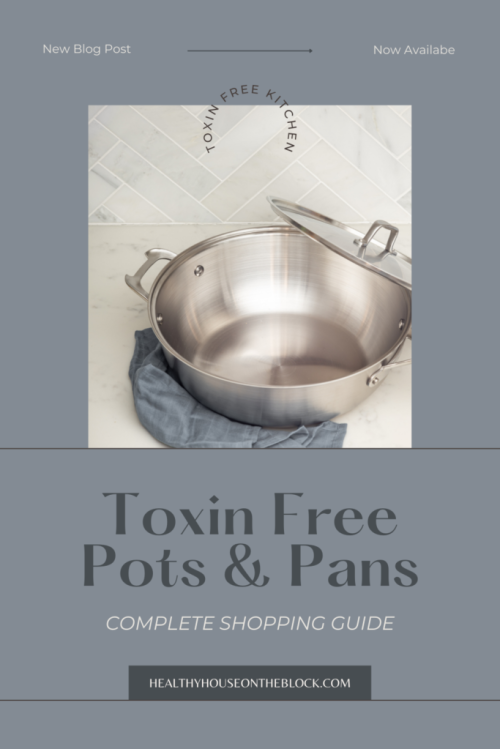
Non toxic pots and pans are an excellent way to make your home a healthier, less toxic space. It’s one of those areas you actually can have COMPLETE control over while you’re at home, so it’s high on my list of priorities when it comes to changes and swaps you can make.




Most of the products you recommend except for 100% ceramic cookware as well as 100% glass have aluminum used in them.
Hi, I’m looking to buy new cookware., and ofcourse I would like healthy cookware for my family. Thank you for being so informative about what to and not to buy. My question is: you mentioned that aluminum is bad for us, but the recommended stainless steel Calphalon pans were good. When I looked them up on the link at amazon, it says that the inside is aluminum and the outside is stainless steel. Did I miss something? Or misunderstand ?
Hi Monique! Thank you so much for the great question. Aluminum core or interior, is considered safe as our food is never touching it. The focus for the pans is really on the exterior coating and surface. I should have explained it more in the blog post 🙂 I hope that helps! Please let me know if you have any other questions at all!
Do you have an opinion of the HexClad brand cookware?
HexClad is non-stick, which there is not a toxin free version of YET. It’s a better option than teflon non-stick, but not as toxin-free as cast iron, stainless steel or 100% ceramic.
Hi Amanda, my husband I are going to replace our old non-stick pots and pans. It’s overwhelming trying to find safe cookware that is non-stick, dishwasher safe/easy to clean, not outrageously priced, and light enough so that it’s easy to hold and maneuver with one hand while cooking. What do you use at your home and why did you choose that brand/line over another? Thank you!
Hi Meg! I know it is REALLY tough to find something that is easy to clean AND toxin-free. We use a variety of pans based on what we are cooking. Cast iron, stainless steel and 100% ceramic Xtrema have worked really well for us. Stainless steel is probably use on a regular basis most often. We clean it with a bamboo pan scraper, which helps A TON with cleaning. We also switched from non-stick, and it was just a learning curve getting used to cooking with them.
Hi there! What are your thoughts on lead free mamas testing of Xtrema and finding very high levels of multiple metals I closing Lead and cadmium? Was interested in a set from them until I read her report. Yikes!
Hi Jessica! Thanks for stopping by! I actually just read the blog posts by Tamara about this (thanks for sharing them with me!). I am truly someone who does both sides of research, so I’ll be checking in with Xtrema to see if there are other independent studies done on their pans that could offer more insight.
Hi Amanda,
I am shopping for pots and pans for my daughter who is setting up house soon. I have looked at so many brands, my head is spinning. I have been looking primarily at Zwilling and Henckels International stainless steel sets. Do you have any opinion on these brands.? Also, i was considering All Clad nonstick stainless steel pots and pans., but after reading your blog on the potential toxicity of non stick i am now afraid to go there. thanks a bunch,
Doranna
Hi Doranna!
Anything that is stainless steel is a really good option. And I would stay away from ANYTHING that is non-stick. No matter if they say it doesn’t contain PFCs and PFAs, we really don’t know the health effects of some of the other non-stick materials that are being used currently. If you’re going to get stainless steel, make sure it’s a TRULY uncoated option. Zwilling and Henckels have lines that are ceramic enameled stainless steel, which is unsafe.
Hi Amanda, I have been going crazy trying to find the best (safest) cookware for my family. There are 2 toddlers in our family and I want the best for them so I am going crazy reading very conflicting reviews. What would you say is the best pan for eggs and omelets taking into consideration the sticking element? I want the ones that resist sticking without the added chemicals if such a pan exists. Thank you so much for your opinion.
Hi Angela! Well, anything that’s TRULY 100% non-toxic will probably have SOMETHING in it that’s not 100% toxin free. I think it’s important to remember though, that this is still a safer and better option than non-stick Teflon. Some examples of a MOSTLY toxin free non-stick pan would be a ceramic coated pan such as GreenPan or Caraway Home. The only reason I wouldn’t give either of these the 100% toxin free stamp is because we just don’t know enough about some of the materials used in these pans to make them non-stick. I personally would be fine using them, but I’m more middle of the road when it comes to this. Otherwise, the other option is to change HOW you cook a little bit and stick with a cast iron or stainless steel pain.
Angela, I want to thank you for sharing the difficulty you’ve been having finding a quality pot set to use. Last night I was so exasperated at this process that I had to “talk myself down from the tree.” When I read your post I felt a little less crazed.
The one thing I have decided to do is not get a pot set from one brand alone. I am going to try different stainless steel brands that I know are reasonably safe and made without the nasty chemicals, and see how they perform.
Jeanne — I truly love our stainless steel and I feel so confident when I use them! Great choice!
Amanda, thank you so much. I know I’m driving myself crazy with this but the more I read, the more complex it seems. I value your opinion and I am going to look at the pans you mentioned above. Thank you again for taking the time to respond to me.
Hi, thanks for the great info.
I have a silly question – on the one area – “Healthy Options Cookware” – it reads > Ceramic – find 100% ceramic. a ceramic that is coated with a glaze can contain lead or cadium (Xtrema).
You have the word Xtrema, does that mean do not buy Xtrema because its coated with a glaze or Xtema is good to buy?
Thank you
Sorry i reread and understand 🙂
Pingback: Toxic Heavy Metals Symptoms from Home Exposure »
Pingback: Year End Healthy House Review: Looking Ahead to 2024 -